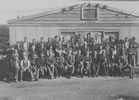Before powered machinery, farming was heavy, time-consuming manual labour. Fields were tilled using horse or bullock-drawn ploughs. Cows were milked, sheep shorn, and crops planted and harvested using human or animal power. The introduction of steam engines and later internal combustion engines improved efficiency. But it was electricity that transformed life on the farm.
Electricity and dairy farming
Hydro-electricity generation began on a small scale in the late 19th century, and the benefits were soon obvious. Electricity was clean, reliable and instant. It could provide heat and light, and power machines.
Electricity was particularly useful on dairy farms, where it could be used to run milking machines, light milking sheds, and heat water for cleaning and sterilising. Small power companies in Taranaki built their own hydro-electric plants in the late 19th and early 20th centuries, and began to supply local towns and farms. In the first decade of the 20th century small electricity-generating stations were mainly found in dairying regions like Taranaki, Waikato and Southland.
Distribution to farms, 1918–36
In 1908 the government took control of the generation, supply and sale of electricity. From 1918 it gave priority to extending electricity lines to farms, to help develop agriculture. Power boards were set up, and had to ensure that the network reached the countryside. Until mains power became available, many farmers had their own water wheels or diesel generators. By 1936, 80% of farms had access to electricity. It was used for a wide range of farming equipment, including shearing machines, pumps and milking machines.
Women and electricity
The arrival of electricity was impatiently awaited in Cheviot county, Canterbury, in the late 1930s. At a Country Women’s Institute meeting one woman was overheard saying, ‘When are we going to get this electricity? No wonder women won’t live in the country, wet wood, a coal range and breakfast at quarter to seven. WHAT A LIFE!’ 1
Domestic use
Electricity was first used for farming and industrial purposes, and street lighting. In the 1920s, even in towns, its use in the home was confined to lighting, and ironing from a special ‘ironing point’. To have electric water-heating and an electric stove, a house needed extensive additional wiring. Only the homes of the wealthy were powered entirely by electricity – most houses had stoves and water heaters fuelled by wood, coal or gas.
From the late 1920s the extension of the power network, and a drop in the price of electrical appliances, changed this situation. In 1936, 80% of farms had electricity; all of these had electric lighting and an electric iron. About one-third had a vacuum cleaner, electric range and electric hot-water cylinder. Electrical appliances began to relieve some of the burden of domestic work for farming women.
Extending lines, 1945–65
After Second World War restrictions were lifted, there was a huge increase in demand for electricity for both industrial and domestic use. A further effort by power boards to construct new lines to rural districts took place, and between 1948 and 1965 another 12,766 households were connected.
Industry changes, 1980s–2000s
Changes in the structure of the electricity industry in the 1980s, and privatisation of some of the state’s interests in 1999, led to an increased emphasis on electricity as a commercial commodity. In the early 2000s power companies were obliged by law to supply ‘uneconomic’ consumers such as farmers. This requirement was due to expire in 2013, but farmers saw its extension as a necessity.


